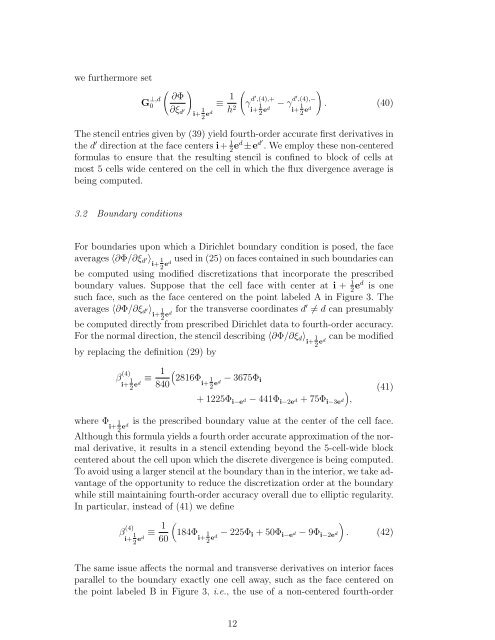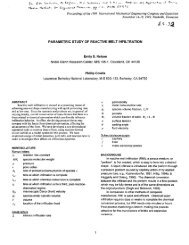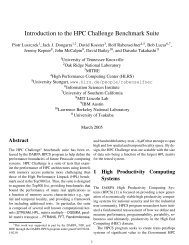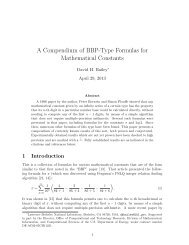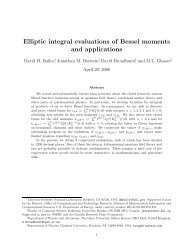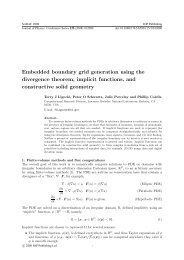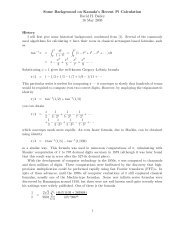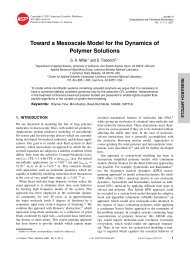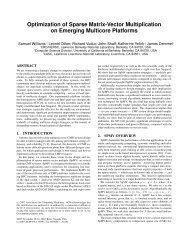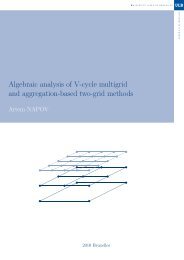High-Order, Finite-Volume Methods in Mapped Coordinates
High-Order, Finite-Volume Methods in Mapped Coordinates
High-Order, Finite-Volume Methods in Mapped Coordinates
You also want an ePaper? Increase the reach of your titles
YUMPU automatically turns print PDFs into web optimized ePapers that Google loves.
we furthermore setG ⊥,d0( ∂Φ≡)i+ 1 (1 h 22 ed∂ξ d ′)γ d′ ,(4),+i+ 1 − γ d′ ,(4),−2 ed i+ 1 . (40)2 edThe stencil entries given by (39) yield fourth-order accurate first derivatives <strong>in</strong>the d ′ direction at the face centers i+ 1 2 ed ±e d′ . We employ these non-centeredformulas to ensure that the result<strong>in</strong>g stencil is conf<strong>in</strong>ed to block of cells atmost 5 cells wide centered on the cell <strong>in</strong> which the flux divergence average isbe<strong>in</strong>g computed.3.2 Boundary conditionsFor boundaries upon which a Dirichlet boundary condition is posed, the faceaverages 〈∂Φ/∂ξ d ′〉 1 i+used <strong>in</strong> (25) on faces conta<strong>in</strong>ed <strong>in</strong> such boundaries caned2be computed us<strong>in</strong>g modified discretizations that <strong>in</strong>corporate the prescribedboundary values. Suppose that the cell face with center at i + 1 2 ed is onesuch face, such as the face centered on the po<strong>in</strong>t labeled A <strong>in</strong> Figure 3. Theaverages 〈∂Φ/∂ξ d ′〉 1 for the transverse coord<strong>in</strong>ates d′ i+ ≠ d can presumably2 edbe computed directly from prescribed Dirichlet data to fourth-order accuracy.For the normal direction, the stencil describ<strong>in</strong>g 〈∂Φ/∂ξ d 〉 1 i+can be modifieded2by replac<strong>in</strong>g the def<strong>in</strong>ition (29) byβ (4)i+ 1 ≡ 1 (2816Φi+ 12 ed 840− 3675Φ 2 ed i+ 1225Φ i−e d − 441Φ i−2e d + 75Φ i−3e d),(41)where Φ 1 i+is the prescribed boundary value at the center of the cell face.ed2Although this formula yields a fourth order accurate approximation of the normalderivative, it results <strong>in</strong> a stencil extend<strong>in</strong>g beyond the 5-cell-wide blockcentered about the cell upon which the discrete divergence is be<strong>in</strong>g computed.To avoid us<strong>in</strong>g a larger stencil at the boundary than <strong>in</strong> the <strong>in</strong>terior, we take advantageof the opportunity to reduce the discretization order at the boundarywhile still ma<strong>in</strong>ta<strong>in</strong><strong>in</strong>g fourth-order accuracy overall due to elliptic regularity.In particular, <strong>in</strong>stead of (41) we def<strong>in</strong>eβ (4)i+ 1 ≡ 1 ()184Φ 12 ed 60− 225Φ i+2 ed i + 50Φ i−e d − 9Φ i−2e d . (42)The same issue affects the normal and transverse derivatives on <strong>in</strong>terior facesparallel to the boundary exactly one cell away, such as the face centered onthe po<strong>in</strong>t labeled B <strong>in</strong> Figure 3, i.e., the use of a non-centered fourth-order12


